| What is it? |
| Cubital tunnel syndrome is the effect of pressure on the ulnar
nerve, one of the main nerves of the hand. It can result in a variety
of problems, including pain, swelling, weakness or clumsiness of the hand
and tingling or numbness of the ring and small fingers. It also often results
in elbow pain on the side of the arm next to the chest. |
|
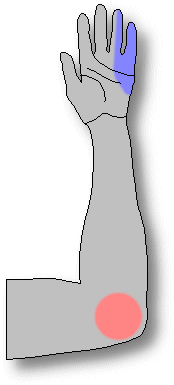 |
|
| What caused it? |
-
Like a telephone cable, the ulnar nerve is a connection between the
spinal cord and muscles of the forearm and hand as well as the skin on
the pinkie side of the hand. The ulnar nerve passes across the back of
the elbow, behind a bump on the inner side of the upper arm bone. This
bump is called the medial epicondyle. The "funny bone" is actually the
corner of the nerve as makes the bend around the elbow. Hitting the elbow
at this spot tickles the nerve and gives a brief feeling of a shock or
tingling.
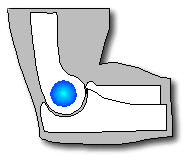 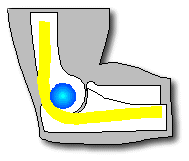
-
When the elbow is bent, the nerve may be stretched and push against the
bony bump.
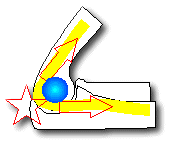
-
Most people with this problem have a habit of sleeping with either their
elbows bent, their arms up by their head, or both. These positions aggravate
the problem. Over time, this can progressively irritate the nerve, resulting
in numbness of the ring and small finger, weakness of some of the
muscles of the hand and forearm, and pain. Nerve damage may occur.
|
| What can you do to help? |
-
"Over the counter" non-steroidal anti-inflammatory medication (NSAID),
such as aspirin, ibuprofen, naprosyn, or ketoprofen.Check with your pharmacist
regarding possible side effects and drug interactions.
-
Take Vitamin B6 100 mg daily (not more) - controversial, but can't hurt,
and might help. If you are pregnant or receiving vitamin therapy already,
first check with your doctor.
-
A splint or brace use while sleeping to keep the elbow from bending while
you sleep - there are several home remedies which may be tried at bedtime:
try at your own risk:
-
Wrap a towel around the elbow, like a "pig in a blanket", and hold in place
with tape or safety pins.
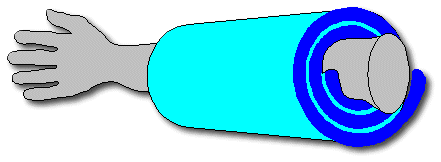
-
Use a small size soft knee splint from a sports store, but wear it on the
elbow.
-
Tie a scarf around your waist and then around your wrist.
-
Watch and modify your posture during the day to avoid long periods of time
with your elbow bent. If you work at a desk, make more space between your
work and your chest, so that your elbows are more straight more often.
-
Wait and watch.
|
| What can a therapist do to help? |
-
Provide a custom pad or support to keep your elbow from bending while you
sleep.
-
Help identify aggravating activities and suggest alternative postures.
|
| What can a doctor do to help? |
-
Confirm that this actually is the problem. This may require special nerve
tests done by a neurologist.
-
Prescribe stronger NSAID medication or cortisone-type medication.
-
Prescribe hand therapy and/or a custom prescription splint.
-
The most effective treatment without surgery is elbow splinting and correction
of aggravating postures. Splinting while sleeping is usually not needed
more than a month, because after that, your arm position during sleep changed
enough to go without the splint.
-
Surgery for cubital tunnel syndrome is intended to provide more space for
the nerve and tendons, and permanently reduce the amount of pressure on
the nerve. There are several ways to do this, including the two following
approaches:
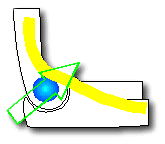 |
One common type of surgery is to move the nerve in front of the bump
so that it doesn't catch and stretch when the elbow is bent. This is called
an ulnar nerve transposition. The nerve can be moved just under
the skin or beneath the muscle in the area. |
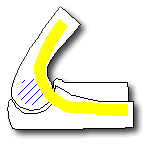 |
Another type of operation is to remove the bump, allowing the nerve
to glide forward and back as the elbow bends and straightens. This is called
a medial epicondylectomy. |
-
Other operations are also possible, and the choice depends on the surgeon's
personal experience and opinion, as well as the anatomy of the individual
elbow.
|
| How successful is treatment? |
-
Depending on several factors, conservative treatment (no surgery) may provide
provide long-term relief in as many as four out of five people. Conservative
treatment is usually not recommended for patients who have evidence of
nerve damage.
-
For people who don't get better with conservative treatment, surgery helps
about four out of five people. Some people will have some permanent areas
of numbness around their elbow or forearm as a result of surgery.
|
| What happens if you have no treatment? |
-
It depends on how much scar tissue has formed around the nerve. Some people
will improve on their own, but it is impossible to predict who will. The
longer the nerve is irritated, the harder it is to have a full recovery.
-
If the nerve has been damaged to the point that the fingers don't straighten
properly, they may not recover the ability to straighten even with surgery.
|
|



